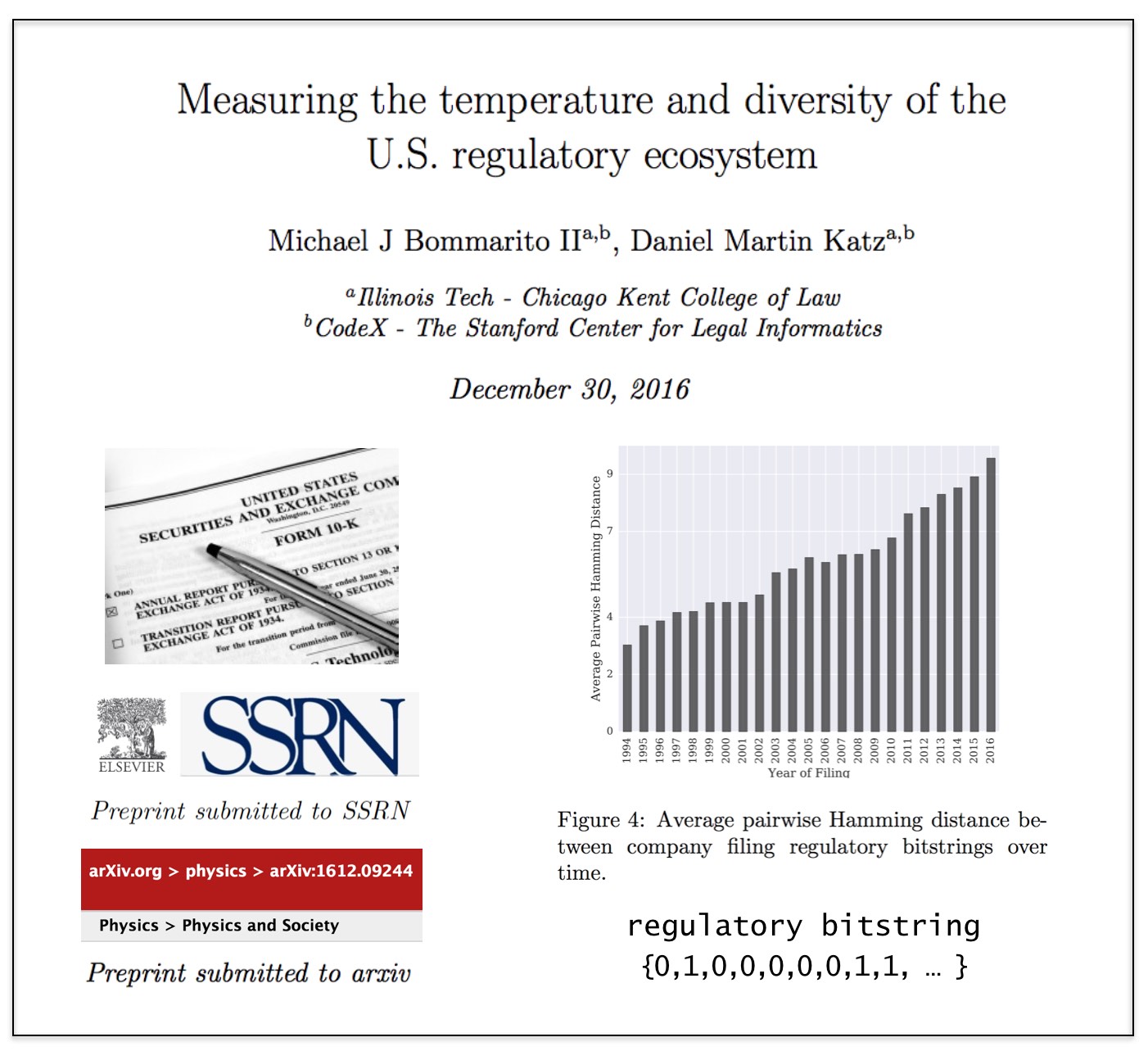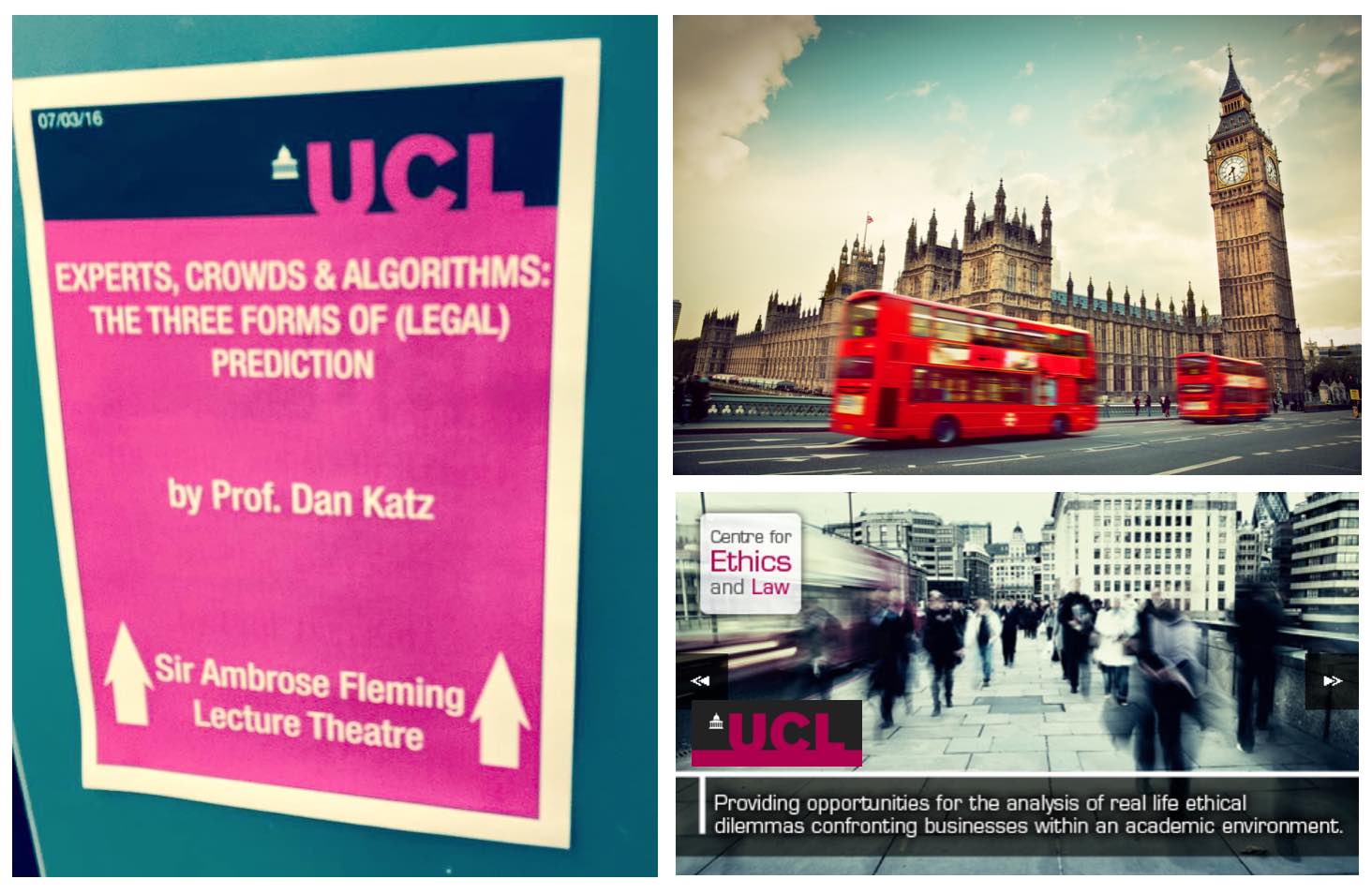
Academic Tour Continues – tomorrow I will be giving a talk at Bar Ilan University here in Tel Aviv at their Law & Big Data Workshop – it is looks like an good agenda with proper scientific papers with technical results / or discussions about methodology. #LegalScience #LegalData #LegalInformatics
Tag: big data and law
Presentation at Legal Innovation Event with Kennedy Van Der Laan and European General Counsels

As my part of my final day in Amsterdam – it was my great pleasure to join with my friends from the Dutch Law Firm – Kennedy Van Der Laan (co-founded by the Mayor of Amsterdam Eberhard van der Laan) for a Legal Innovation Event. The event combined sessions in data, technology and design thinking for a variety of European General Counsels.
Harnessing Legal Complexity – Bring Tools of Complexity Science to Bear on Improving Law (Ruhl, Katz & Bommarito in Science Magazine)
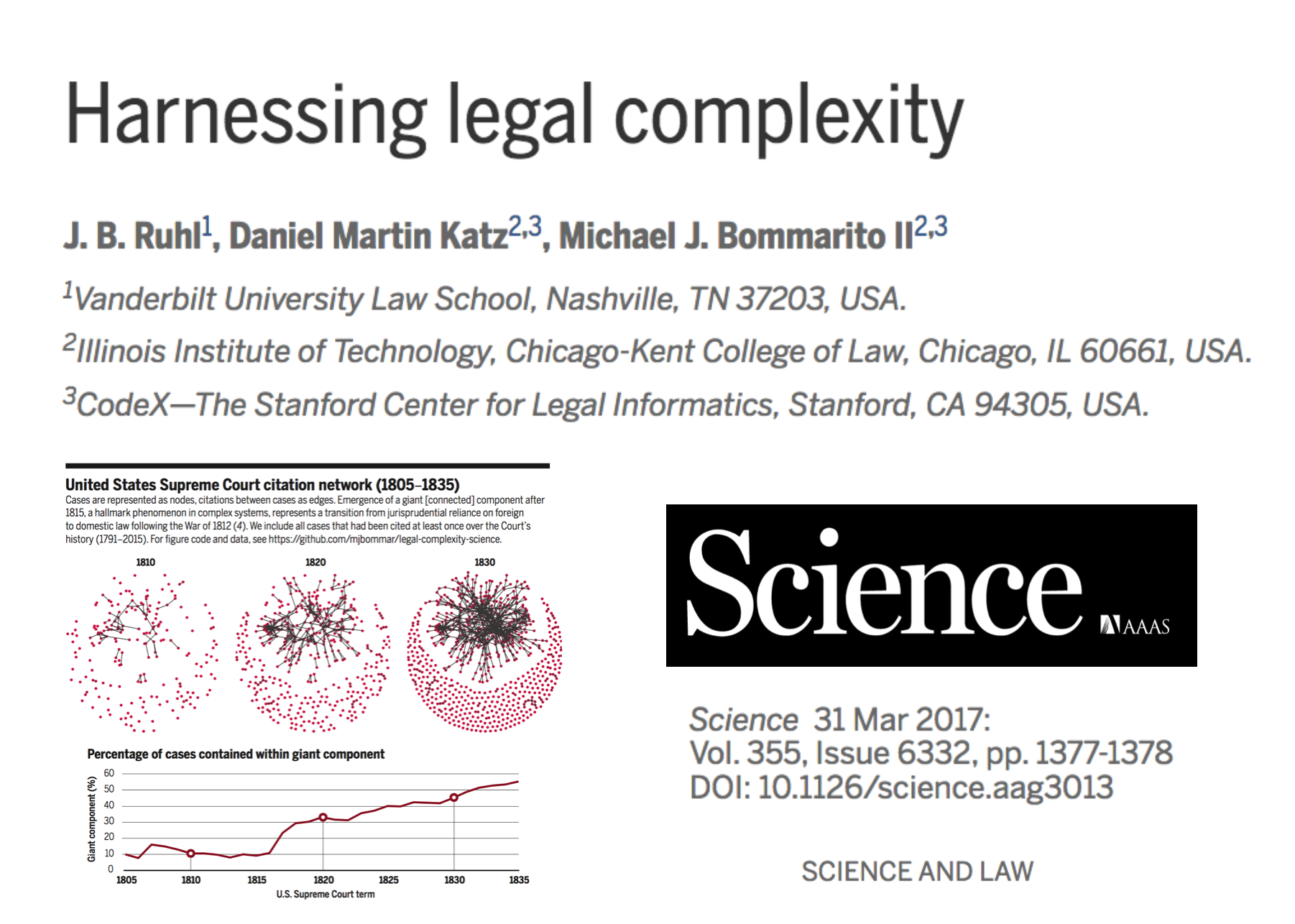
We have been working in the field of Law + Complex Systems for more than a decade (starting during the time that Mike Bommarito and I were graduate students at the University of Michigan Center for the Study of Complex Systems) – today we took a big step forward with publication our article in the March 31 Edition of Science Magazine. It was a great pleasure to work with J.B. Ruhl & Michael Bommarito on this paper!
The rate at which US Companies cite regulations as an obstacle has quadrupled over the last 20 years (via Quartz)
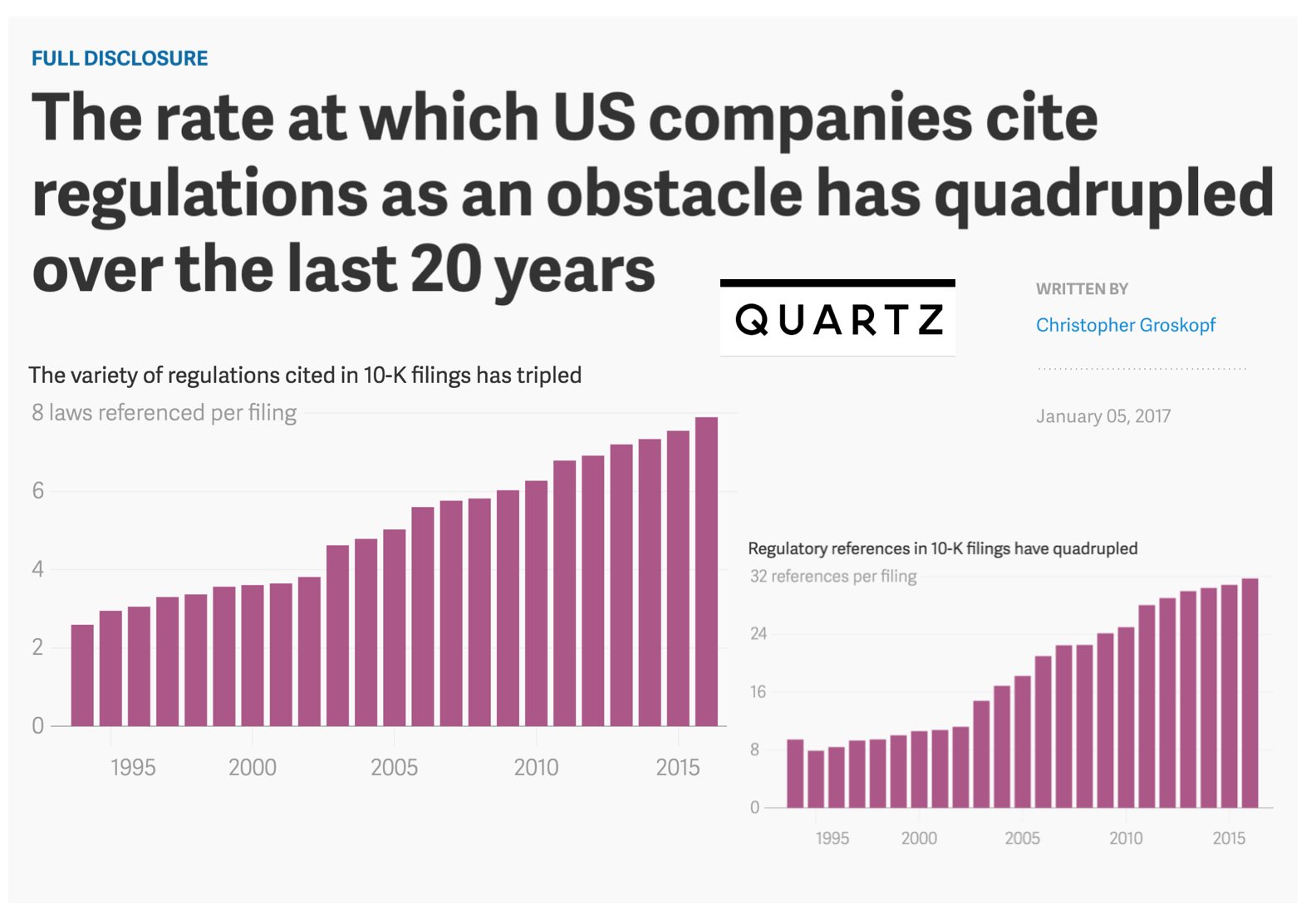 “Michael Bommarito II and Daniel Martin Katz, legal scholars at the Illinois Institute of Technology, have tried to measure the growth of regulation by analyzing more than 160,000 corporate annual reports, or 10-K filings, at the US Securities and Exchange Commission. In a pre-print paper released Dec. 29, the authors find that the average number of regulatory references in any one filing increased from fewer than eight in 1995 to almost 32 in 2016. The average number of different laws cited in each filing more than doubled over the same period.”
“Michael Bommarito II and Daniel Martin Katz, legal scholars at the Illinois Institute of Technology, have tried to measure the growth of regulation by analyzing more than 160,000 corporate annual reports, or 10-K filings, at the US Securities and Exchange Commission. In a pre-print paper released Dec. 29, the authors find that the average number of regulatory references in any one filing increased from fewer than eight in 1995 to almost 32 in 2016. The average number of different laws cited in each filing more than doubled over the same period.”
Measuring the Temperature and Diversity of the U.S. Regulatory Ecosystem (Preprint on arXiv + SSRN)
From the Abstract: Over the last 23 years, the U.S. Securities and Exchange Commission has required over 34,000 companies to file over 165,000 annual reports. These reports, the so-called “Form 10-Ks,” contain a characterization of a company’s financial performance and its risks, including the regulatory environment in which a company operates. In this paper, we analyze over 4.5 million references to U.S. Federal Acts and Agencies contained within these reports to build a mean-field measurement of temperature and diversity in this regulatory ecosystem. While individuals across the political, economic, and academic world frequently refer to trends in this regulatory ecosystem, there has been far less attention paid to supporting such claims with large-scale, longitudinal data. In this paper, we document an increase in the regulatory energy per filing, i.e., a warming “temperature.” We also find that the diversity of the regulatory ecosystem has been increasing over the past two decades, as measured by the dimensionality of the regulatory space and distance between the “regulatory bitstrings” of companies. This measurement framework and its ongoing application contribute an important step towards improving academic and policy discussions around legal complexity and the regulation of large-scale human techno-social systems.
Available in PrePrint on SSRN and on the Physics arXiv.
Artificial Intelligence and Law – A Six Part Primer
Above is my keynote address at the Janders Dean Legal Horizon Conference in Sydney. It is a mixture of some earlier talks I have given – together with some new materials.
Quantified Law Primer & Agile Legal Project Management Workshop

In conjunction with Janders Dean International, and SeyfarthLean Consulting we are excited to offer two, half-day educational sessions on July 13th 2016.
Quantified Law Primer (Morning SESSION)
Instructors: Daniel Martin Katz (Chicago-Kent College of Law), Karl Haraldsson (Janders Dean), and Andrew Baker (Janders Dean)
Agile LPM Workshop (Afternoon SESSION)
Instructors: Kim Craig (SeyfarthLean Consulting), Andrew Baker (Janders Dean), and Justin North (Janders Dean)
These workshops are to be held in conjunction with the Chicago Kent- Janders Dean Legal Horizon Conference on July 14th in Chicago. The Legal Horizon event features more than 20+ speakers in a single day, single stage event.
Legal Tech Asia – Hong Kong 2016
It was a great pleasure to deliver the opening keynote at LegalTech Asia 2016 here at the JW Marriott in Hong Kong. The event draws leading legal professionals from across the Asia-Pacific region. It was a great to connect with everyone as part of a global conversation directed toward moving the profession forward!
The Advanced E-Discovery Institute @ Georgetown Law
 Tomorrow I will be speaking on the opening panel at the Advanced E-Discovery Institute @ Georgetown Law. The event draws hundreds of lawyers and technologists to Washington DC to discuss the latest advances in the rapidly evolving field of E-Discovery.
Tomorrow I will be speaking on the opening panel at the Advanced E-Discovery Institute @ Georgetown Law. The event draws hundreds of lawyers and technologists to Washington DC to discuss the latest advances in the rapidly evolving field of E-Discovery.
Law Firm COO & CFO Forum Pre-Conference Workshop on Big Data / Legal Analytics / Legal Informatics
 Yesterday I had the pleasure of participating in the Thomson Reuters Law Firm COO & CFO Forum Pre-Conference Workshop on Big Data. The half day workshop explored various way that law firms and outside counsel can use data to be better lawyers and run better businesses.
Yesterday I had the pleasure of participating in the Thomson Reuters Law Firm COO & CFO Forum Pre-Conference Workshop on Big Data. The half day workshop explored various way that law firms and outside counsel can use data to be better lawyers and run better businesses.
Here is the information for my panel (below) and the full program is located here.
Few business trends are as simultaneously revered, derided, appreciated or ignored as that of big data. Used (somewhat flippantly) to describe large, complex data sets that resist traditional data processing applications, big data represents both a beginning and end for many professional industries ill- prepared to harness big data’s myriad benefits and value. This opening conversation lays the framework for our program by addressing four key questions and concerns:
- What is big data?
- Why should we use it?
- Where does it lie within a business organization?
- How do we identify ROI and value in big data investment?
Moderator:
John Fernandez – US Chief Innovation Officer and Partner Dentons; Global Chair, NextLaw Labs
Panelists:
Justin Ergler – Director, Alternative Fee Intelligence and Analytics, GlaxoSmithKline
Daniel Martin Katz – Associate Professor of Law, Illinois Institute of Technology Chicago-Kent College of Law; Chief Strategy Officer, LexPredict
Michael S. Klastava – Vice President, Global Head of Legal Data & Analytics, American International Group, Inc.
Christopher Zorn – Liberal Arts Research Professor of Political Science and Sociology, The Pennsylvania State University; Principal, Quantitative Analysis, Lawyer Metrics
Econometrics (hereinafter Causal Inference) versus Machine Learning
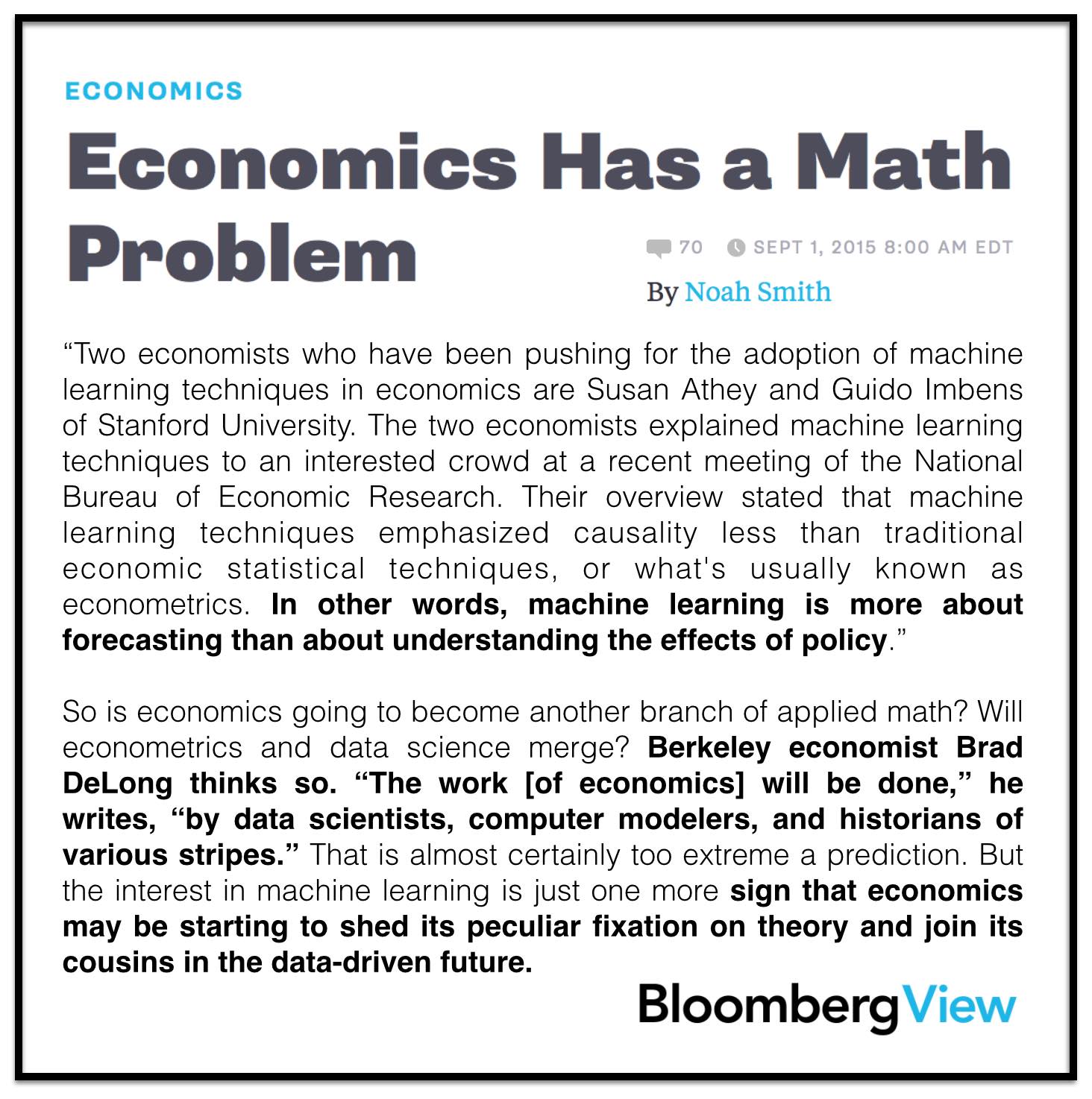 Perhaps some hyperbolic language in here but the basic idea is still intact … for law+economics / empirical legal studies – the causal inference versus machine learning point is expressed in detail in this paper called “Quantitative Legal Prediction.” Mike Bommarito and I have made this point in these slides, these slides, these slides, etc. Mike and I also make this point on Day 1 of our Legal Analytics Class (which really could be called “machine learning for lawyers”).
Perhaps some hyperbolic language in here but the basic idea is still intact … for law+economics / empirical legal studies – the causal inference versus machine learning point is expressed in detail in this paper called “Quantitative Legal Prediction.” Mike Bommarito and I have made this point in these slides, these slides, these slides, etc. Mike and I also make this point on Day 1 of our Legal Analytics Class (which really could be called “machine learning for lawyers”).
Legal Analytics – Introduction to the Course – Professors Daniel Martin Katz + Michael J Bommarito
Here is an introductory slide deck from “Legal Analytics” which is a course that Mike Bommarito and I are teaching this semester. Relevant legal applications include predictive coding in e-discovery (i.e. classification), early case assessment and overall case prediction, pricing and staff forecasting, prediction of judicial behavior, etc.
As I have written in my recent article in Emory Law Journal – we are moving into an era of data driven law practice. This course is a direct response to demands from relevant industry stakeholders. For a large number of prediction tasks … humans + machines > humans or machines working alone.
We believe this is the first ever Machine Learning Course offered to law students and it our goal to help develop the first wave of human capital trained to thrive as this this new data driven era takes hold. Richard Susskind likes to highlight this famous quote from Wayne Gretzky … “A good hockey player plays where the puck is. A great hockey player plays where the puck is going to be.”

